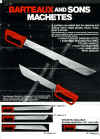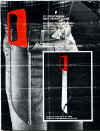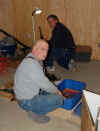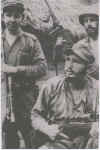February 2008
Knife Prices
Knife prices are continually edging up, is this a favorable trend? Depends on if you are selling or buying. It hurts the new collector and prevents many from entering the hobby. It helps the long established collector who has a sizeable investment. That said, it's market dynamics. The value of things are determined by the demand that exists, there is someone out there paying the inflated prices. There's nothing unfair about that, just depends on your point of view.
Quote
Just in case you think optimism is dead, the average pencil is seven inches long with just a half inch of eraser.Robert Brault
Brass Use During WW II
No definitive answer that I know of. The war started for the US on Dec 7, 1941 but it wasn't until October 21, 1942 manufacturers were told to stop using copper in almost all civilian use products. A few days after VE-day, May 6, 1945, producers of civilian goods were given permission to place orders for steel, copper, and aluminum for delivery after July 1, 1945 and rating floors were removed to permit placing unrated orders if they did not interfere with war needs. Limitation orders on some 73 types of products were removed, and restrictions of this nature continued to be lifted almost daily during the interim period. While the war didn't last much longer after that date most cutleries had brass on hand that they had been restricted from using, it was simply a matter of getting it from the warehouse and using it. Many even fought to use it or at least sell it during the war but it never happened, red tape I guess. The MIL-K knife was allowed the use of brass as it was a war use item and somehow they talked the War Production Board into it. The Pocket Knife Industry Advisory Board was a virtual Who’s Who of the knife industry and most of them had offices right in Washington. When not working on selling knives and taking orders from the government they were working on advisory boards.Could it have been used on making knives, sure. Most are probably post war made items but all sorts of things happened in those years of the war, Cole made huge brass knuckle knives didn’t he.
US Military Kitchen Cutlery as a Collectable?
Not at all sexy but there are quite a few models of military kitchen cutlery that are routinely overlooked by collectors. Many in fact have not been identified such as the flour de lies marked aluminum handled mess cutlery. Who are they?? It is a very commonly found mess kit knife so must have been made in very large numbers but so far an unknown. Many of the butcher knives are marked by the manufacturer and even dated to some degree. This all adds up to big buck if it were an M3 but alas the kitchen knives are still rather cheap when compared. Now some folks think they are worth a mint when they have one for sale but will probably end up dying with it when priced too high. Collectors won’t pay it and for what ever reason they are uncommon to find in excellent condition. They are working tools, they got used up rapidly so finding a really nice dated butcher or cooks knife is harder then finding a V42. Think about it.A hard one to find is Village Blacksmith and the company has a wonderful history to go with it. The name first saw usage in 1898 by the Washington Cutlery Company of Watertown Wisc. The staple products of this company were working butcher and kitchen knives. During World War Two we see the USMC Hospital Corps knives made by Village Blacksmith. They had at least two contracts in 1942 for these items in the amount of 18,000 and 27,500 items each. The Village Blacksmith name still exists, it is now owned by a California company called Olympia Group. The working kitchen, butcher, skinning knives from VB can be found with contract data, US markings and even dated on some. Quite a collection could be amassed in these knives but it would be work, they are not seen all that often.
Here’s a one to think about…
(Australian AP) A police sergeant and two constables were patrolling outside Brisbane, Qld., Australia, when their vehicle was struck by lightning. "Everything went on, the siren, lights, horn," said Sgt. Craig Shepherd. "It was one of the most freakiest things I've ever seen." The officers proceeded to limp the damaged vehicle back to the station, the siren blaring the whole way so they could get the tools to disconnect the siren. I guess constables in Australia don’t carry pocket knives with them, between the three of them you would think at least one of them would have a knife!
Worth
Sometimes the issue between rare and or uncommon and actual demand gets blurred. Rare or uncommon isn't ’ an open invitation to having items reproduced or faked, demand is. Another thing to look for is condition. A true rare item we should pick up is just about any condition while an item in demand we should only look at the best possible condition we can afford. A terrible example of an item in demand yet readily available with some searching would be a poor decision to purchase. Many items in demand can often be found in perfect condition. Two perfect examples are the V42 and the M3, both of which are in high demand and neither of which are rare or even uncommon, they are just in high demand. Because they are often found in near mint to perfect condition, there is a tremendous price drop on examples with even the smallest defects. The more I study prices the more convinced I become that price is dictated soley upon demand, rarity does not figure into price. Demand is fueled by exposure in movies, books, magazines, websites and talk forums, the increased exposure escalates pricing. Romance plays a big part in the demand as well, association with highly exposed groups escalates pricing, hence the V42 is super expensive as it was associated with the extremely well known First Special Service Force, the Black Devils, the Force, the Devils Brigade etc. Movies and several books have been written about them, the knife is extremely well made and looks great, it has all the attributes of a classic collectable yet is isn’t even close to rare, they are consistently found for sale in near mint condition on down. On the flip side super rare knives can be worth very little because there is no demand. In many cases they are unknown as they have had little to no exposure. Everyone knows about the USMC 2nd Raiders and the Collins little machetes they carried but few know about the USMC 1st Raiders and the Camillus hunting knife they carried. That Camillus wouldn’t bring $100.00 in perfect condition on a great day because few know what they look like and even fewer know how to tell.
What Hope is There for Antique Arms Collectors in UK?
from "The Daily Telegraph" 18th Jan. 2008.
"PUT AWAY YOUR ARMS DRAMA GROUP IS TOLD".
A village amateur dram group performing Robinson Crusoe has had to tell
police about the use of plastic swords because of health and safetl fears.
The Carnon Downs Dram Group, at Perranwell, Cornwell, must lock up its two
plastic cutlasses, six wooden swords and a toy gun when they are not in use
and appoint a "responsible guardian" for them.
The group said it informed police about the use of replica weapons after
studying new health and safety guidlines and new legislation to crack down
on violent crime.
"We have got several wooden and plastic swords, two plastic spears and a gun
that cost £2 from a joke shop. But now we need to keep them locked away."
The National Operatic and Drama Association said it supported the new policy
because "it enables weapons to be used safely and legally in theatrical
performances".
Heaven help us all in UK.Sent to us by Good Friend Peter White in the UK
Some Truths I Have Learned From Collecting Knives
- When you find something good at a show that you want to buy, do NOT set it down on the table to count the money you have on you. Someone standing next to you will scoop it up and make an offer.
- Do not offer an opinion on a friends newest purchase unless you are badgered to do so, you may not be friends afterwards.
- If you are in a crowd of guys and hear someone say, "Anyone got a knife", walk away. Do not reach into you backpack and pull out the WW II Randall you just purchased. They do not want to look at it, knives are made to cut things, even old ones.
- Big tough knives can be broken by dropping them.
- Styles change, high quality and excellent condition are constants.
- Prices will vary by make, model, condition, day of the week, weather, mood, etc, see number 5 above.
- eBay is not the enemy.
- Newbies, you have to ask for help before you can receive it.
- When you buy that first fake knife, mount it on the wall as a constant reminder. Note I said when, not if.
- Forget High School, books are our friends.
- Even the largest collections start with a single knife.
- Sometimes missing a great deal can be fun as well, it creates a great memory to tell your friends how the big one got away.
- Occasionally sell a knife and go through great pains to let your wife know you sold it. It is like the old adage of a man doing a load of wash, if she didn’t witness you doing it did you really do it?
- Sneak one back in to replace it.
- Regrets are stupid useless human emotions. Another one will come along.
- Always keep in mind, this is a hobby and it is supposed to be fun.
- A sack full of money is cool but a sack full of knives makes me happier.
- Finding a single page with a knife fact I didn’t know, in a building full of billions of pages still amazes me.
- I purchase more books and paperwork then knives in any given year but I am still a knife collector.
- The truth behind that knife story is typically simple because unlike fiction it doesn’t have to make sense.
- Helping others who attempt to help themselves makes me feel good. I don’t believe in handouts but I do believe in a hand up.
- Real knife people are good people.
- My best research luck always comes when I try my hardest.
- Like Jiminy Cricket says, Always let your conscience be your guide.
- Knives are sharp, even old ones.
Be on the Lookout for a Few Stolen Knives.
I saw your ads for the BC-41 knives and wanted to ask you to please be on the lookout for two BC-41 knives that were stolen from me in Washington State. One is an older BC-41 style knife, an original Clements that looks exactly like a BC-41 but is unmarked with a brass handle and the knuckles are slightly blunted. The handle was originally blackened but most of the black finish has worn off from handling over the years and only remains mostly in the recessed areas. The blade is not blackened and has some patina and pitting. The other one is an old H.G. Long reproduction knife (offered through the VA Knife Collector Club) limited edition BC-41 with extensive scrollwork on the brass handle, has a bright blade, and is in mint condition. It was in a wooden case with sliding glass top and red velvet lining. The knife was marked number 101 of 700 (I'm not absolutely positive of the exact number, but it's very close to that). There were also two original U.S. 1918 LF& C Mark 1 Trench knives stolen with the two BC-41 knives. Both had original scabbards, one knife & scabbard was in near mint condition, and the other one had seen some use. There were also some M6 leather sheaths with them. As a fellow collector, could you please be on the lookout for these knives, and let me know if anyone contacts you trying to sell them. They are VERY important to me. The original unmarked BC-41 belonged to my grandfather, and one of the LF&C knives belonged to my step-dad, who carried it in the Pacific in WWII. They were stolen sometime around Sept. '07. There were several other knives stolen along with them, but those are the ones that I'm mainly concerned about.
thank you - Brian Sandberg
Israeli Use of the Mk2 and Other Knives
We hear from good friend Sa’ar who explains some of the items we spoke about back in the Novemeber posting and adds to it with some items we were not aware of. Many US knives made it to Israel post WW II in many ways I suppose, direct and indirectly. Sa’ar explains to us that the B&W photo had been taken at the end of the Sinai War at 1956, the one-eyed officer in the middle is of course Gen. Moshe Dayan, then the chief of staff. The officer on the right with the knife is a colonel (later to become general and establisher of the Israeli Natural Reserves Authority), commander of the 9th brigade, the late Abraham Yaffe.
Sa’ar also sent us several pics for our education on the use of the knife and wearing along with Israeli made knives that look like US made items and current use pieces.
First, pics of the Beva knife, note a fuller on one side only. The colored spacer pattern is different on each knife. Very hard blade was sometimes brittle and the high gloss finish was NOT to army specifications. Interesting piece of local militaria and industrial attempt nevertheless.
Palmah – the initials stand for Plugot Mahaz = "Crush Companies", the first special forces during pre-state times, organized underground army. They issued a fighting knife, actually a dagger, made in Tel-Aviv and officially issued. The upper piece is the regular pattern with a brass cap and guard, the lower one is a very rare variation without a cap and having an iron S guard. This dagger supposedly had been issued to the IDF first officer's course graduates. The additional pic shows a Palmah trooper with a dagger on his belt.
Kabars: this is from my personal collection, all have been found here. From left to right: 1st gen. Kabar signed (faintly) only USMC, note the thin Coke-bottle shaped handle and custom made sheath (this knife belonged to my father and the sheath was made for him, bearing his initials, in 1960); unused, mint condition Robeson Suredge without the red spacer; Camillus Mk II, a late Ka-bar marked USN.
Pic Kabar p1 shows paratroopers under the walls of A-Rahwe (Operation Jehonathan, Jordan) police, prior to their explosion, mid 50's. 2nd soldier from left clearly has a kabar on his webbing; the last soldier (frontal from back) has a TL-29 lineman's set. The left soldier is Marcel Tobias, father of the IDF airborne brigade and one of the most decorated fighters of the IDF.
Pic Kabar p2 is from the Sinai War 1956, the big guy on the left also has a kabar, just right to his canteen.
Attached is a photo of a lineman set, which is a late period (1960's) copy of the American made set. Note the leather sheath is marked with the IDF letter Z (for ZAHAL = IDF), attached is a close-up copy of the stamp. The pliers are of quality British manufacture, stamped with a small Z on the pivot and the folding knife is an Israeli made copy of the Camillus knife. Again, one blade is marked Z. There was an unknown quantity of original American sets, I know of several in collections over here, usually only the sheath is marked.
Thanks for the education Sa’ar!
Camillus MIL-K knives
When I toured the plant for the auction sale the work stations were full of parts ready to assemble. They left for the strike and pretty much never came back to work. The blades in all the bins were dated 2006 and the finished and partly finished knives were all 2006 dated. No 2007 dated blades were anywhere to be found, they did not start making them yet. So for those of you keeping count we have the single 1949 knife and then continuous production with every year stamped from 1957 to 2006. A fifty-year continuous run of the simple MIL-K pattern knife, blows my mind to think about it. If the new owners of the name start up production of this pattern we will have a definite cut off period with the 2006 date being the last produced by the original Camillus firm in Camillus NY.
Barteaux Machetes
Can anyone help in dating Barteaux machetes or knives for that fact. What should we be looking for to give us some clues on the age. These patterns have been around for quite some time now and are legitimately old so a new one could fool the owner into thinking it is an older one and the other way around as well. Just has me wondering…
They Are Still Out There
Inspiring email received here…Morning Sir
I was doing some reading on your web page on the Case V42 WW II landing knife. Well my father in law has one he got from a friend for 200 dollars a month ago and I would like to know if I could send you pics of it to see what you think of it
Thank you for your time
Some folks just live right I guess… Here are the pictures of an original Case V42 Ships Landing Force knife as issued on the USS Omaha.
Updated March 2008
Quote
The Enemy
Somewhere a True Believer is training to kill you. He is training with minimal food or water, in austere conditions, training day and night. The only thing clean on him is his weapon. He made his own web gear. He doesn't worry about what workout to do - his ruck weighs what it weighs, his runs end when the enemy stops chasing him. This True Believer is not concerned about 'how hard it is;' he knows either he wins or dies. He doesn't go home at 17:00, he is home.
He knows only The Cause.Unknown.
Sea Wolf Knives Revisited
Gus Marsh was with the US Navy and from 1967-1970 with UDT-13 in the Philippines and Vietnam. He made 26 of the three-piece diving knife for his SEAL and UDT buddies. The most visible difference between the two knives is that the three-piece knives have no name on the handle. From 1980-1984 he made about 200 Seawolf diving knives and sold them at Gun Shows in California, Arizona and Nevada. These knives were made from 440C stainless steel and hardened to the Rockwell C scale of 57-58. He retail sold them for $150.00 each with either a leather or kydex sheath. Gus has not made anymore since 1984. In 1986 Gus sold the rights to the Seawolf knife to Mike England from Oklahoma, who according to Gus never paid him for it. Mike has since died and Gus has moved on. The above information is right from Gus.
Some Interesting Vietnam War Facts.......
The oldest KIA was 63 years old.......the youngest KIA was 15 years old.......at least 5 KIA's were 16 years old.......at least 12 KIA's were 17 years old.......at least 25,000 KIA's were 20 years old or younger.......17,000 KIA's were married.......997 KIA's were killed their 1st day in Vietnam.......1,448 KIA's were killed their last day in Vietnam.......8 women were KIA.......50,112 KIA were white.......7,264 KIA were black.......115 KIA were asian.......226 KIA were American Indian.......467 KIA were listed as other.......38,196 ARMY.......2,555 NAVY....... 2,583 AIR FORCE.......14,837 MARINES.......7 COAST GUARD.I thought I might add that the 50,112 Caucasian KIA's include 3,070 Hispanics. The U.S. government did not begin keeping separate statistics on Hispanics until 1979.
Thanks to Bill Humes and Gunbarrel for the above info.
Excerpt from Rex Applegate
In June of 1940 the bulk of the British army, reeling from the advancing German blitzkrieg, was evacuated from the French beaches at Dunkirk to safety across the English Channel. The British nation licked its wounds and reorganized for a total was effort. It was a discouraging and bleak picture that faced the nation when Winston Churchill was called from political obscurity to lead the battle against Germany. In times of extreme national adversity it is not uncommon-as in Churchill's case- for gifted men to appear on the scene. Such men were W.E. Fairbairn and E.A. Sykes. Had it not been for World War II, they well have lived out their retirements in relative obscurity in the Far East. Then the modern fighting man would never have benefited from their experiences and skills in hand-to-hand combat. It was my good fortune, because of assignment to the Office of Strategic Services (OSS), to work with both "Dan" Fairbairn and "Bill" Sykes. During the six months of 1942, my association with Fairbairn took place at one of the first OSS training centers, designated Area B, near Thurmont, Maryland. (The site of Area B is now known as Camp David and serves as the presidential retreat). Later in 1942 I had a tour of duty in England in the area of Fort Williams and Achnacarry, Scotland. It was here that I had the opportunity to work with Sykes. Both Fairbairn and Sykes were close to retirement from the Shanghai police when they were called to active duty and given the rank of captain. They were declared too old for combat duty and were assigned to training operations. Stories abound, however, of how they tried to circumvent their non-combat classification in favor of front-line service. Looking back over forty years to my associations with these famous fighting men, I have several lasting impressions. Fairbairn was the more flamboyant and aggressive of the two. He had a more basic interest in unarmed combat and knife-fighting techniques. Sykes, a more reserved individual, had more expertise in firearms. Both excelled in all phases of close combat with and without weapons. Fairbairn always carried his razor sharp, First Pattern F-S knife in its sheath sewn to the lining of the right-hand pocket of his battle dress uniform. He frequently, and unexpectedly, would draw the knife from its concealed location and place the point at either the throat of stomach of various OSS personnel whom he was meeting for the first time. Needless to say, he got their attention and left more then a lingering impression. One night at the Army and Navy Club in Washington after a number of scotch and sodas, he stuck himself in the thigh while sheathing the knife. What the British call a "bloody mess" ensued. One of my most prized possessions is a Wilkinson Sword F-S knife given to me by Dan Fairbairn in the summer of 1942. My first meeting with Sykes was short on conversation. Sykes outfitted me with a brand new Sten Gun and a Webley revolver and had me run through a combat course in the basement of a medieval Scottish castle. He had installed a comprehensive combat range complete with targets in German uniforms (that fired blanks at the trainee), booby traps, and other devices. Apparently, I did well enough because a close relationship with Sykes followed. Sykes died of pneumonia late in the war. After the end of hostilities, Fairbairn, who spent the later war years in the United States, was promoted to lieutenant colonel and was active for a number of years on various training assignments. He died at his home in England in the 1960s. Both men left a legacy of close combat techniques and training methods that are in use to this day. But the Fairbairn-Sykes knife was undoubtedly their most famous contribution to the fighting men of their own and postwar generations. The Fairbairn-Sykes Commando dagger in its various configurations is certainly the most famous, special issue combat blade in modern military history. Although of British origin, it has become equally famous on this side of the Atlantic. Its original design has spawned imitations and variations that are still being manufactured. Beautifully executed commemorative knives, made by the original manufacturer, Wilkinson Sword are being marketed to collectors and persons interested in World War II weapons and memorabilia. As recently as the Argentine-British war in the Falklands, it was reported that special units of the British Army. The fighting men and the public throughout the free world recognizes the symbolism of crossed F-S knives on shoulder patches and other insignia, indicating elite troops and offensive military operations.Col. Rex Applegate
The Army and Navy Club
Washington, D.C.
USMC BOYT 43 Sheath
I just purchased on eBay a sheath marked USMC / Boyt / 43. As you may know this is a fairly elusive sheath to find and a great addition to a World War Two era 1219C2 Fighting / Utility knife in any collection. The sheath was in mint condition and although the marking was lightly struck it is no doubt to what it reads. The sheath is tightly stitched and has the proper nine (9) brass staples around the perimeter stitching for added reinforcement should the stitching split or in some way come undone. The sheath was relatively inexpensive, heck it was downright cheap and except for the fact that is it newly made every thing would have been great. That’s right folks the USMC / BOYT / 43 marked Mk2 sheath is being reproduced. Shown here are a few photographs of the sheath and the markings. The large brass snap is a plain giveaway and if you compare the old and the new the font on the stamping is different. It is a quality sheath but be aware they are out there and will no doubt be aged and passed off to the unsuspecting.
A New Book in the Works
Well we just finished taking a few hundred photographs of some of the finest M3 Trench Knives on the planet. Every possible combination of markings and configuration you could possibly think of and then some or so it seemed. My back still hurts from thinking about it. M6 sheaths still in the packaging along side the M8 and M8A1’s of different eras were included as well. Knives still in the original boxes with the printing on the outside as well as post war factory examples and even a few theatre modified as well. Some factory experimental’s were also on hand and a few more still to do. Then if that alone wasn’t enough the M4 bayonet was added as well. World War Two era pieces, wood handles, rubber handles, and the more modern era plastic handles were all included. Again all possible types and markings were included. This collection of knives and bayonets was impressive to say the least. Several more pieces that were not available are being scheduled for a photo shoot and examination.So any way the pieces were all assembled to shoot the photos for the new book by Vince Coniglio and Doug Yates. The United States M3 Trench Knife and M4 Bayonet-Knife; 1943 to Present. That’s right, the Coniglio M3 book is in the works for and update. No date for publication has been set so far but the two gentlemen are getting all the parts together. Along with all the photos I dumped hundreds of documents on the guys, many that have not been written about and all sorts of small minutiae about the knives and the bayonets. It looks like it is underway and should be a welcome new addition to the collecting world.
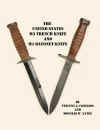
The new book and Vince and Doug unpacking some Good Stuff!
El Presidente of Cuba wears a Mark 2
Here is a photograph sent to us by good friend Miguel Carrillo Diaz. It shows the image of from left to right, Raúl Castro -the new President of Cuba, Fidel Castro and Camilo Cienfuegos circa 1959, somewhere in the Cuban mountains of Sierra Maestra during the revolution against the troops of General Batista. It seems that Raul is carrying a Mark 2 knife to me! Great photo, thanks Miguel!
E-Mails…
Last month we ran a piece about deals still being out there. We also received quite a bit of mail on the subject both pro and con for a multitude of reasons. To me they are light hearted stories and give me the will to press on, thinking that next piece may be just around the corner for me. It helps to balance out the negatives about the fakes and forgeries as well. Here is one of the best e-mails received…Now, let's see, believe it was the "father-in-law" (?) who
bought the Case "V42" Ships Landing Force knife from
a friend for $200.00 (same as Special Service Force ? -
almost hope the guy is pulling "our collective leg" - lol)!
And the "rough" estimated value, of the genuine article
"V42" in the condition displayed in those photos would
be how many thousands - what do you think - are they
still "friends" ? ? ? If the "tale" truly occurred as told - I
would be inclined to believe the gentleman has already
passed right by "living right"... and is moving full speed
ahead in the direction of "saint-hood"! Thank you again
and will be in touch...

